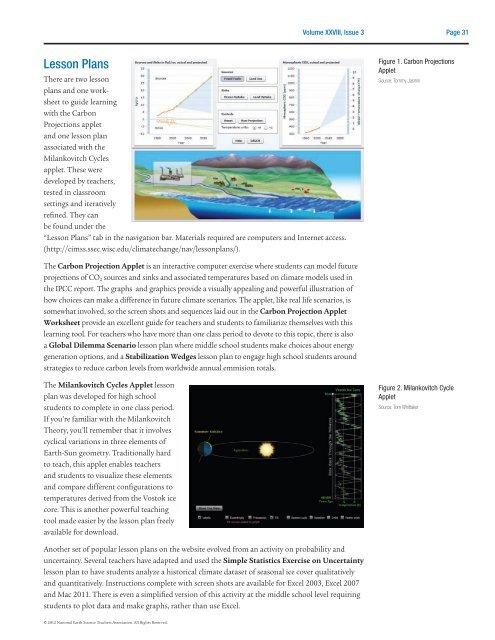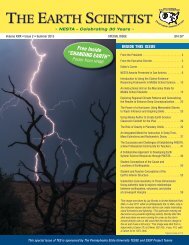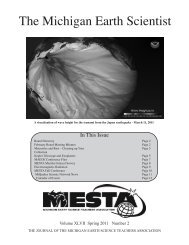The Earth Scientist
Fall 12.pdf - NESTA
Fall 12.pdf - NESTA
- No tags were found...
You also want an ePaper? Increase the reach of your titles
YUMPU automatically turns print PDFs into web optimized ePapers that Google loves.
Volume XXVIII, Issue 3<br />
Page 31<br />
Lesson Plans<br />
<strong>The</strong>re are two lesson<br />
plans and one worksheet<br />
to guide learning<br />
with the Carbon<br />
Projections applet<br />
and one lesson plan<br />
associated with the<br />
Milankovitch Cycles<br />
applet. <strong>The</strong>se were<br />
developed by teachers,<br />
tested in classroom<br />
settings and iteratively<br />
refined. <strong>The</strong>y can<br />
be found under the<br />
“Lesson Plans” tab in the navigation bar. Materials required are computers and Internet access.<br />
(http://cimss.ssec.wisc.edu/climatechange/nav/lessonplans/).<br />
Figure 1. Carbon Projections<br />
Applet<br />
Source: Tommy Jasmin<br />
<strong>The</strong> Carbon Projection Applet is an interactive computer exercise where students can model future<br />
projections of CO 2 sources and sinks and associated temperatures based on climate models used in<br />
the IPCC report. <strong>The</strong> graphs and graphics provide a visually appealing and powerful illustration of<br />
how choices can make a difference in future climate scenarios. <strong>The</strong> applet, like real life scenarios, is<br />
somewhat involved, so the screen shots and sequences laid out in the Carbon Projection Applet<br />
Worksheet provide an excellent guide for teachers and students to familiarize themselves with this<br />
learning tool. For teachers who have more than one class period to devote to this topic, there is also<br />
a Global Dilemma Scenario lesson plan where middle school students make choices about energy<br />
generation options, and a Stabilization Wedges lesson plan to engage high school students around<br />
strategies to reduce carbon levels from worldwide annual emmision totals.<br />
<strong>The</strong> Milankovitch Cycles Applet lesson<br />
plan was developed for high school<br />
students to complete in one class period.<br />
If you’re familiar with the Milankovitch<br />
<strong>The</strong>ory, you’ll remember that it involves<br />
cyclical variations in three elements of<br />
<strong>Earth</strong>-Sun geometry. Traditionally hard<br />
to teach, this applet enables teachers<br />
and students to visualize these elements<br />
and compare different configurations to<br />
temperatures derived from the Vostok ice<br />
core. This is another powerful teaching<br />
tool made easier by the lesson plan freely<br />
available for download.<br />
Figure 2. Milankovitch Cycle<br />
Applet<br />
Source: Tom Whittaker<br />
Another set of popular lesson plans on the website evolved from an activity on probability and<br />
uncertainty. Several teachers have adapted and used the Simple Statistics Exercise on Uncertainty<br />
lesson plan to have students analyze a historical climate dataset of seasonal ice cover qualitatively<br />
and quantitatively. Instructions complete with screen shots are available for Excel 2003, Excel 2007<br />
and Mac 2011. <strong>The</strong>re is even a simplified version of this activity at the middle school level requiring<br />
students to plot data and make graphs, rather than use Excel.<br />
© 2012 National <strong>Earth</strong> Science Teachers Association. All Rights Reserved.






